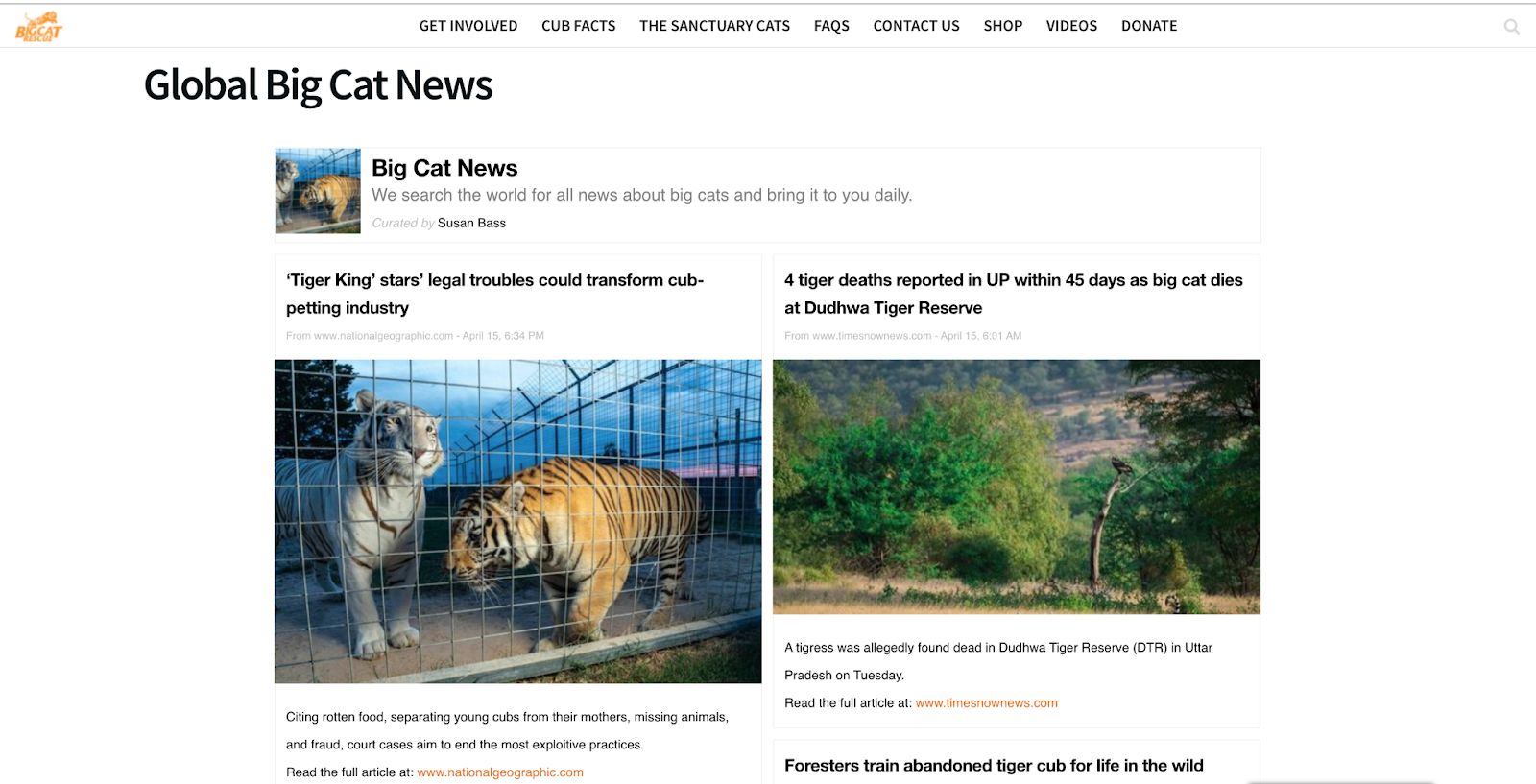
Carole Baskin, founder of Big Cat Rescue, shares how Scoop.it helps them share valuable content with their audiences.
Hi, Thanks for taking the time to speak with me. Could you please tell me about yourself and about what you do?
Carole Baskin: I’m Carole Baskin, I run Big Cat Rescue. We rescue lions, tigers, leopards, bobcats… all kinds of exotic cats from horrible situations. We’ve been doing this since 1992, but our ultimate goal is to put ourselves out of business. We don’t believe that big cats belong in cages, so we are using Scoop.it and all the resources at our command to get the message out here as to why these cats should not be bred for life in captivity.
I agree. Could you tell me about your online presence and how it is managed?
CB: We have about 12 paid staff and 88 volunteers on property, the volunteers do all of the animal care at the sanctuary. But we probably have over 100 volunteers online and we have huge social presences on Youtube, Facebook, Instagram and Tiktok. The 100 or so volunteers online, from all over the world, are answering questions. So whenever someone has a question, whether it be about a situation that they saw recently at a local zoo, how do they report abuse or is it ok to breed white tigers, all those types of questions are being answered by our volunteers online. What I love about Scoop.it is that it gives us a place where we can save all of this information, from everywhere around the world, in a very timely manner. This way our people can use these resources whenever they need to answer questions.
That’s interesting! So do you have more of a management role and public relations for Big Cat Rescue?
CB: Actually my role is more so the future thinking dreamer, that’s my personality! If I had a superpower it would be seeing the future. So in my particular situation, I believe that zoos are quickly going to become a thing of the past and they will have to remake themselves. For the past several years, I’ve been working on computer generated images, virtual and augmented reality experiences. All of these being done in a location based environment, so people will have a reason to go to the zoo, if they can’t afford the expensive headsets for example. By going to the zoo, they will be able to experience all of these different worlds by puting the headsets on and going to where those animals actually are, living freely in the wild. That’s what I spend most of my time and energy working on.
My daughter actually runs the sanctuary. All of the paid staff do administrative jobs. We have two people who manage the 100 volunteers online and two people who manage the 88 volunteers onsite who are taking care of the cats. After that there are other roles, such as accounting, donor appreciation etc, that’s what our paid staff does.
Do you remember how you discovered Scoop.it? I know it was a few years ago…
CB: We had been using Press.ly, I can’t remember if they went out of business or if it became too expensive, but we started looking for an alternative. Scoop.it was the alternative that we chose, but I can”t remember how many years ago that was. Before Scoop.it or Press.ly, the only way you could share stories online was to copy and paste the story, but the original author obviously wanted credit for sharing it in the first place. It provided something very important for us, by giving us a legal way to share the information. The viewer could see a preview of the story and then decide if they wanted to read it. That is really invaluable.
What are the main features that you use?
CB: We used to have one paid employee, a director of public relations, she used to manage our account. Unfortunately, when covid hit we had to scale back half of our administrative staff. Her role was turned over to a volunteer who is a legal assistant. Everyday she runs Google alerts for any stories involving cats, she has to filter out articles for sport teams. Once she finds the important ones, she scoops them to our feed. We use that feed in a couple of different ways. There is a page on our website, which is about 10 000 pages of information, one of the main pages we link to is https://bigcatrescue.org/scoop/.
That page has the embedded feed from Scoop.it, so it always gets the most recent stories. Then, everyday I make a video that we put out to Facebook and Youtube called “The Daily Big Cat” which is reporting about the news that day all around the world, and I read all of that off of the Scoop.it feed. We also have a coordinator that talks about everybody who came to the site, and what it was like with pictures that are also included in the video after the news.
We have a couple of other websites, one of them is https://911animalabuse.com/, where we also include the embedded feed from Scoop.it.
That website is dedicated to helping people decide if the zoo they are thinking of going to is a respectable place or not. The idea is that while they are finding that out, they are also learning about other issues thanks to the Scoop.it feed. It’s a great way to provide that information.
Could you tell me what your favorite feature is?
CB: It would be how easy it is to embed the content to our website!
Do you use the bookmarklet or do you copy and paste the links?
CB: We copy the URL, put it into our topic and then embed that to our website.
Would you be interested in creating a newsletter for your viewers?
CB: There are so many stories out there that people aren’t going to be willing to read about each one, which is why I make those videos to highlight the most important ones each day.
That makes sense. Thanks a lot for your time! I’m glad that you enjoy using Scoop.it, don’t hesitate to reach out to us if you have any questions!




